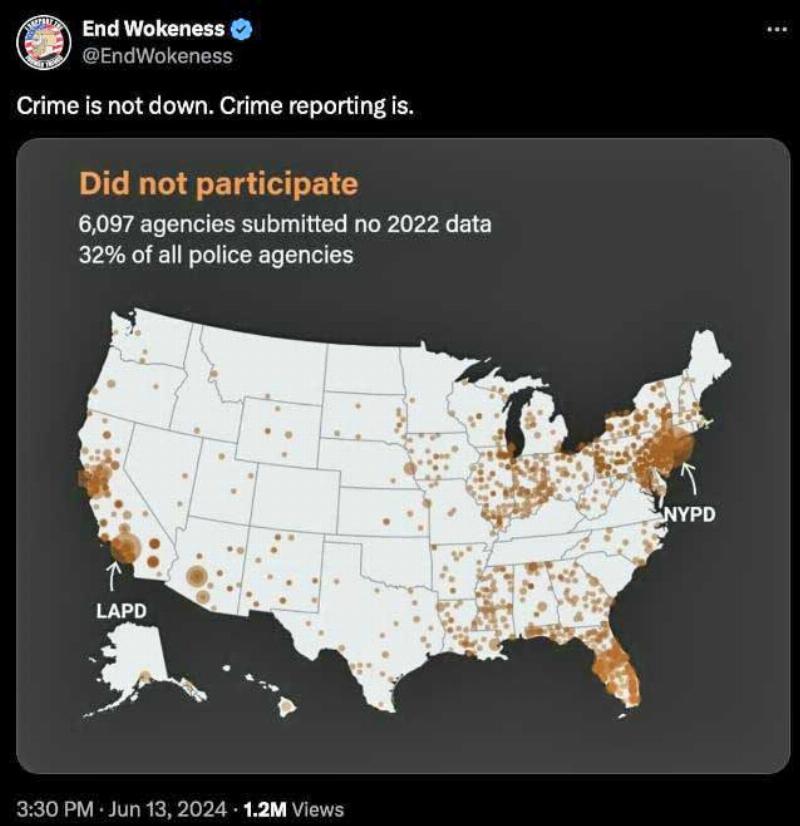


Mark Twain famously observed: “There are lie, damned lies and statistics.”
Circa August 2025, Americans have learned government statistics, and particularly crime statistics, are best taken with a truckload of salt. In June of 2024 I wrote Lies, damned lies and statistics, a tale of how untrustworthy is the FBI’s yearly Uniform Crime Report, once the gold standard for such things. Biden’s Handlers all but destroyed American’s trust in the FBI, and government in general. The second Trump Administration is laboring to restore at least some of that trust, but it’s a daunting task. On the bright side, in destroying trust in government Democrats have reduced trust in the Democrat Party to historic, abyssal, lows. In that 2024 article, I noted:
In recent years, many cities—most blue—have stopped reporting crimes to the FBI. No reports, no crimes. Circa 2024, as many as 7000 agencies are keeping that sort of information to themselves. The graph illustrates where most of that lack of reporting occurs. Notice it’s largely in major population centers. In 2022 even Wyoming’s first and second largest towns didn’t report, but those numbers, compared to California and NYC, are tiny.

Graphic: X Post
Cities aren’t reporting to the FBI for two primary reasons that reflect the blue/red divide. Blue cities and states are loath to report their skyrocketing crime rates because they reveal the utter failure of Democrat policies and worse, reveal out of control crime is a conscious choice. Blue cities and states don’t have to be cesspools of violent crime. Democrats just like it that way. Criminals are among their most treasured constituents.
Red cities and states, recognizing what’s going on, aren’t reporting because they’ve lost confidence in the FBI, not only to fairly and equally enforce the law, but to honestly report crime statistics. They also know that their crime rates, small in comparison to blue cities and states, look worse when blues lie and the FBI credulously prints whatever they’re told.
On one hand, it’s useful to have a reliable, national source of crime data. On the other, the best source is people living in cities like DC. Told there’s no crime, they know better as they’re carjacked and there’s a shooting on their front lawn for the fourth time this month.
Apparently trying to take up the FBI’s slack, the Bureau of Justice Statistics isn’t doing any better, but perhaps for somewhat different reasons:
On the heels of the recent controversy over major statistical revisions of unemployment data by the Labor Department, the Bureau of Justice Statistics (BJS) has just released a report containing highly questionable state violent crime rates. The report’s unreliable numbers are not the result of errors in calculation or any deliberate attempt to skew the results. Rather, they are the product of applying a methodology that is incapable of producing accurate results for the statistical categories in question. Indeed, they provide further evidence of the folly of parroting the mantra, “Trust the experts.”
The BJS’s latest report, covering 2017 to 2019 and 2020 to 2022 asserts the violent crime rate in Arizona for those periods dropped by about 50%. Unfortunately for the BJS, the Phoenix PD, the biggest police agency in Arizona, reported its homicide rate rose 42% and the overall violent crime rate rose 9% during those times. Ooops.
How could the BJS be so wrong? They rely on the National Crime Victimization Survey (NCVS), which doesn’t contain police submissions, but interviews actual crime victims. That should be a good thing, except during 2020 and 2021—the Covid hysteria—the Census Bureau suspended all in-person crime victim interviews, which made all data for those years useless. In 2020, the FBI reported an all-time high 30% murder increase, but the NCVS claimed violent crime dropped. That’s exactly what one would expect if victims weren’t being interviewed. Even with as many as 7000 law enforcement agencies refusing to report to the FBI, an increase is believable primarily because so many blue agencies are trying to hide their crime increases.
In short, statistical agencies’ unwillingness to question their own methodologies or execution can lead to problematic results. When groupthink takes over, such agencies often fail to examine whether the figures produced by a given methodology or process are believable.
Donald Trump has made a good and necessary beginning in restoring trust in government, but it’s going to take a very long time to restore what was so stupidly, purposely and maliciously squandered.
Become a subscriber and get our weekly, Friday newsletter with unique content from our editors. These essays alone are worth the cost of the subscription.
Mike McDaniel is a USAF veteran, classically trained musician, Japanese and European fencer, life-long athlete, firearm instructor, retired police officer and high school and college English teacher. He is a published author and blogger. His home blog is Stately McDaniel Manor.
